Charles Sturt University IT Ethics Assignment 1: Social Media
VerifiedAdded on 2023/06/09
|9
|2465
|317
Essay
AI Summary
This assignment, submitted by a student, analyzes the ethical dilemmas arising from the use of social media in organizations. The student identifies various ethical issues, including the blurring of personal and professional lives, lack of social media policies, the sharing of sensitive information, the creation of digital footprints, and inappropriate use of social media conventions. The assignment explores these issues through the lenses of professional ethics, philosophical ethics (including spamming and privacy concerns), and sociological ethics (including slacktivism and brand image). The analysis provides insights into the complexities of IT ethics and the impact of social media on organizational behavior and societal values. The student uses a case study approach and provides relevant references to support the arguments made.
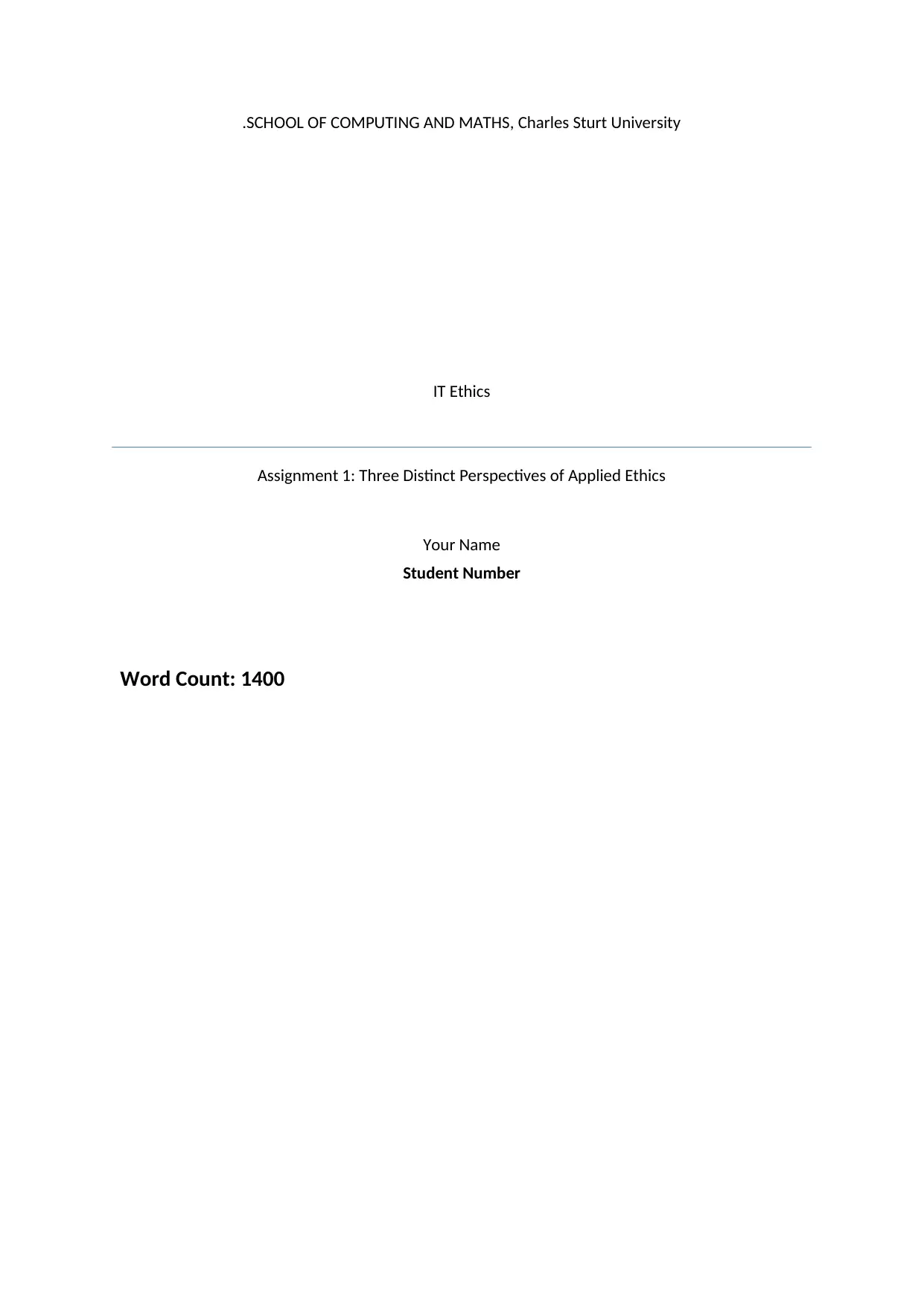
.SCHOOL OF COMPUTING AND MATHS, Charles Sturt University
IT Ethics
Assignment 1: Three Distinct Perspectives of Applied Ethics
Your Name
Student Number
Word Count: 1400
IT Ethics
Assignment 1: Three Distinct Perspectives of Applied Ethics
Your Name
Student Number
Word Count: 1400
Paraphrase This Document
Need a fresh take? Get an instant paraphrase of this document with our AI Paraphraser
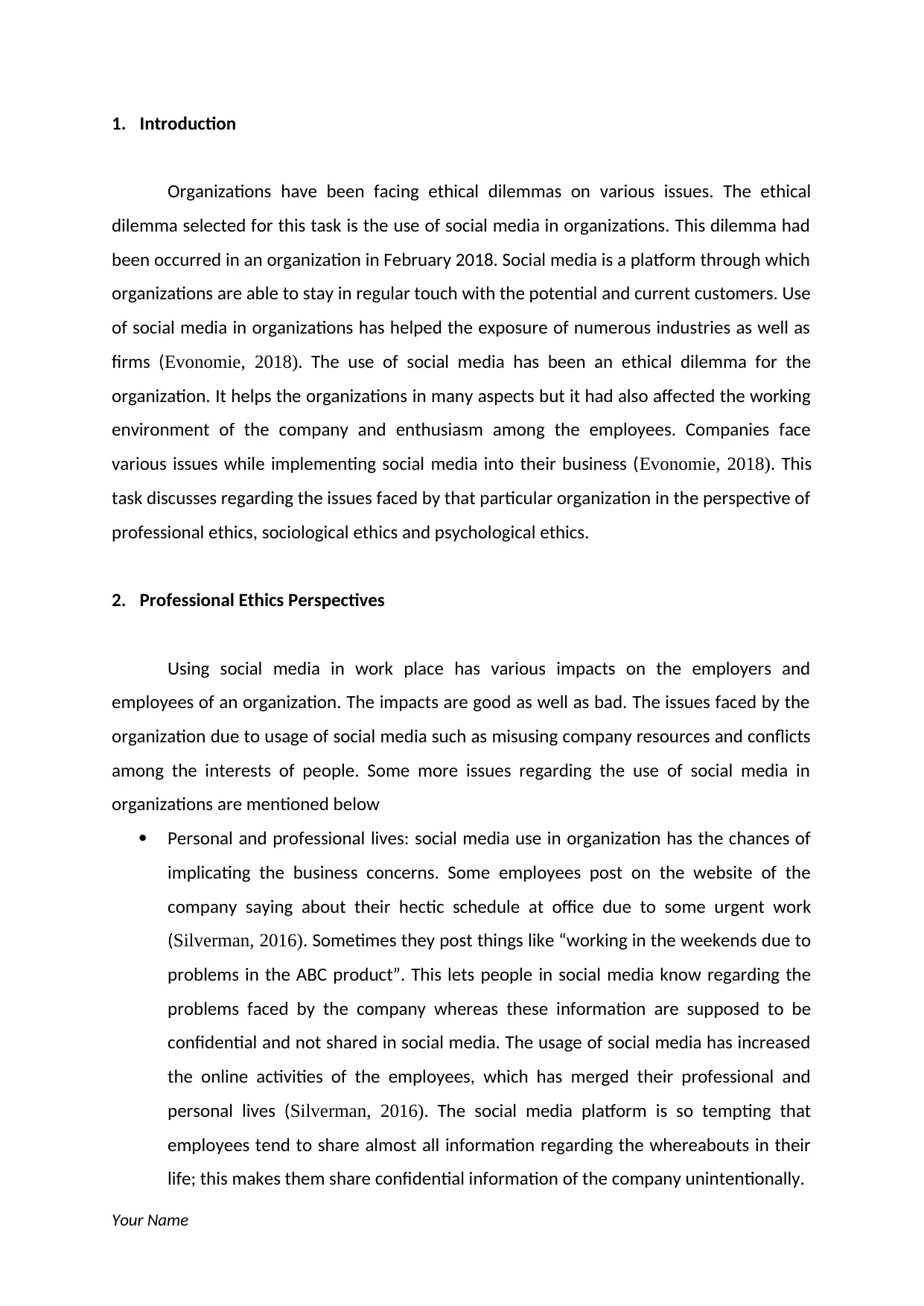
1. Introduction
Organizations have been facing ethical dilemmas on various issues. The ethical
dilemma selected for this task is the use of social media in organizations. This dilemma had
been occurred in an organization in February 2018. Social media is a platform through which
organizations are able to stay in regular touch with the potential and current customers. Use
of social media in organizations has helped the exposure of numerous industries as well as
firms (Evonomie, 2018). The use of social media has been an ethical dilemma for the
organization. It helps the organizations in many aspects but it had also affected the working
environment of the company and enthusiasm among the employees. Companies face
various issues while implementing social media into their business (Evonomie, 2018). This
task discusses regarding the issues faced by that particular organization in the perspective of
professional ethics, sociological ethics and psychological ethics.
2. Professional Ethics Perspectives
Using social media in work place has various impacts on the employers and
employees of an organization. The impacts are good as well as bad. The issues faced by the
organization due to usage of social media such as misusing company resources and conflicts
among the interests of people. Some more issues regarding the use of social media in
organizations are mentioned below
Personal and professional lives: social media use in organization has the chances of
implicating the business concerns. Some employees post on the website of the
company saying about their hectic schedule at office due to some urgent work
(Silverman, 2016). Sometimes they post things like “working in the weekends due to
problems in the ABC product”. This lets people in social media know regarding the
problems faced by the company whereas these information are supposed to be
confidential and not shared in social media. The usage of social media has increased
the online activities of the employees, which has merged their professional and
personal lives (Silverman, 2016). The social media platform is so tempting that
employees tend to share almost all information regarding the whereabouts in their
life; this makes them share confidential information of the company unintentionally.
Your Name
Organizations have been facing ethical dilemmas on various issues. The ethical
dilemma selected for this task is the use of social media in organizations. This dilemma had
been occurred in an organization in February 2018. Social media is a platform through which
organizations are able to stay in regular touch with the potential and current customers. Use
of social media in organizations has helped the exposure of numerous industries as well as
firms (Evonomie, 2018). The use of social media has been an ethical dilemma for the
organization. It helps the organizations in many aspects but it had also affected the working
environment of the company and enthusiasm among the employees. Companies face
various issues while implementing social media into their business (Evonomie, 2018). This
task discusses regarding the issues faced by that particular organization in the perspective of
professional ethics, sociological ethics and psychological ethics.
2. Professional Ethics Perspectives
Using social media in work place has various impacts on the employers and
employees of an organization. The impacts are good as well as bad. The issues faced by the
organization due to usage of social media such as misusing company resources and conflicts
among the interests of people. Some more issues regarding the use of social media in
organizations are mentioned below
Personal and professional lives: social media use in organization has the chances of
implicating the business concerns. Some employees post on the website of the
company saying about their hectic schedule at office due to some urgent work
(Silverman, 2016). Sometimes they post things like “working in the weekends due to
problems in the ABC product”. This lets people in social media know regarding the
problems faced by the company whereas these information are supposed to be
confidential and not shared in social media. The usage of social media has increased
the online activities of the employees, which has merged their professional and
personal lives (Silverman, 2016). The social media platform is so tempting that
employees tend to share almost all information regarding the whereabouts in their
life; this makes them share confidential information of the company unintentionally.
Your Name
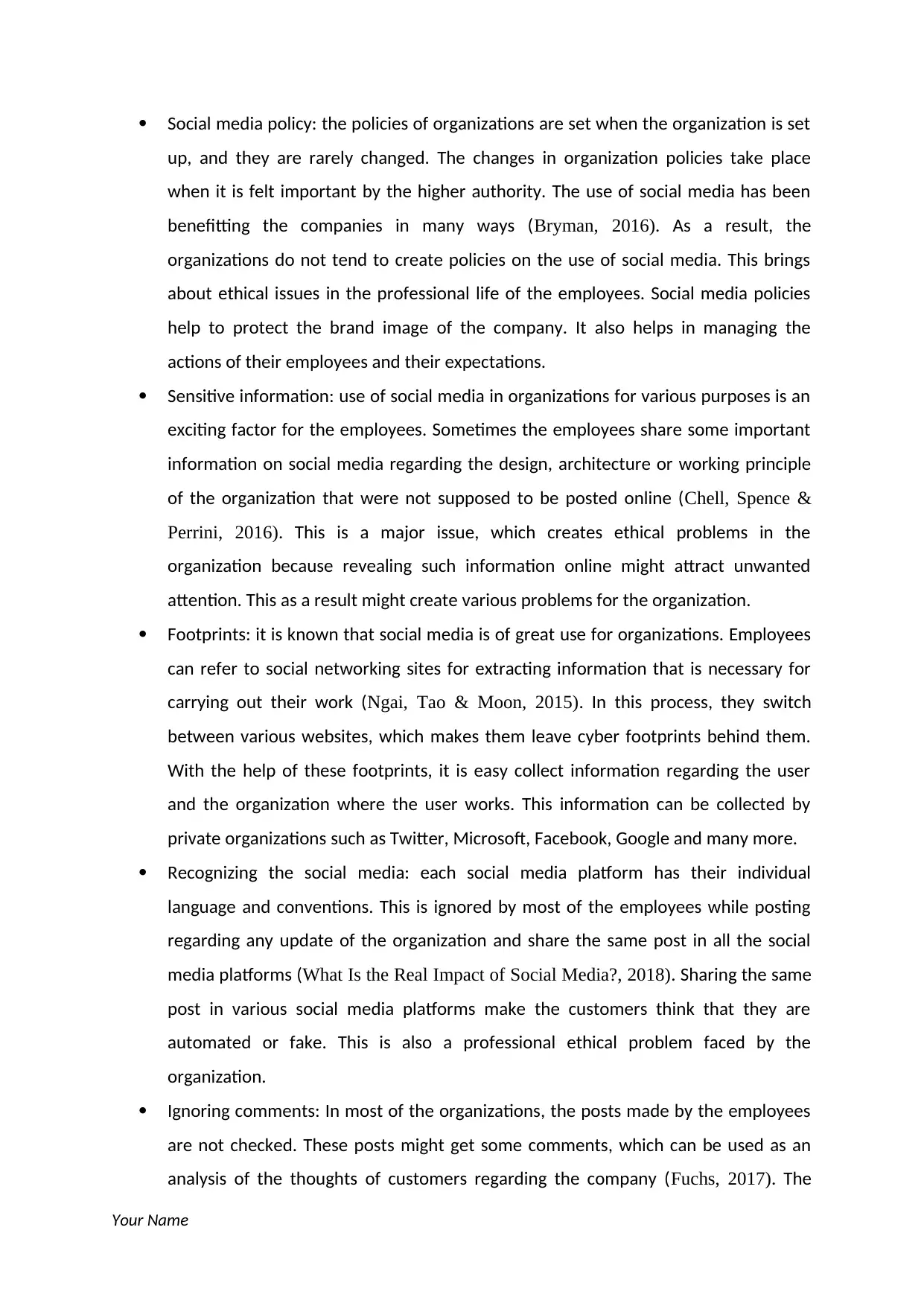
Social media policy: the policies of organizations are set when the organization is set
up, and they are rarely changed. The changes in organization policies take place
when it is felt important by the higher authority. The use of social media has been
benefitting the companies in many ways (Bryman, 2016). As a result, the
organizations do not tend to create policies on the use of social media. This brings
about ethical issues in the professional life of the employees. Social media policies
help to protect the brand image of the company. It also helps in managing the
actions of their employees and their expectations.
Sensitive information: use of social media in organizations for various purposes is an
exciting factor for the employees. Sometimes the employees share some important
information on social media regarding the design, architecture or working principle
of the organization that were not supposed to be posted online (Chell, Spence &
Perrini, 2016). This is a major issue, which creates ethical problems in the
organization because revealing such information online might attract unwanted
attention. This as a result might create various problems for the organization.
Footprints: it is known that social media is of great use for organizations. Employees
can refer to social networking sites for extracting information that is necessary for
carrying out their work (Ngai, Tao & Moon, 2015). In this process, they switch
between various websites, which makes them leave cyber footprints behind them.
With the help of these footprints, it is easy collect information regarding the user
and the organization where the user works. This information can be collected by
private organizations such as Twitter, Microsoft, Facebook, Google and many more.
Recognizing the social media: each social media platform has their individual
language and conventions. This is ignored by most of the employees while posting
regarding any update of the organization and share the same post in all the social
media platforms (What Is the Real Impact of Social Media?, 2018). Sharing the same
post in various social media platforms make the customers think that they are
automated or fake. This is also a professional ethical problem faced by the
organization.
Ignoring comments: In most of the organizations, the posts made by the employees
are not checked. These posts might get some comments, which can be used as an
analysis of the thoughts of customers regarding the company (Fuchs, 2017). The
Your Name
up, and they are rarely changed. The changes in organization policies take place
when it is felt important by the higher authority. The use of social media has been
benefitting the companies in many ways (Bryman, 2016). As a result, the
organizations do not tend to create policies on the use of social media. This brings
about ethical issues in the professional life of the employees. Social media policies
help to protect the brand image of the company. It also helps in managing the
actions of their employees and their expectations.
Sensitive information: use of social media in organizations for various purposes is an
exciting factor for the employees. Sometimes the employees share some important
information on social media regarding the design, architecture or working principle
of the organization that were not supposed to be posted online (Chell, Spence &
Perrini, 2016). This is a major issue, which creates ethical problems in the
organization because revealing such information online might attract unwanted
attention. This as a result might create various problems for the organization.
Footprints: it is known that social media is of great use for organizations. Employees
can refer to social networking sites for extracting information that is necessary for
carrying out their work (Ngai, Tao & Moon, 2015). In this process, they switch
between various websites, which makes them leave cyber footprints behind them.
With the help of these footprints, it is easy collect information regarding the user
and the organization where the user works. This information can be collected by
private organizations such as Twitter, Microsoft, Facebook, Google and many more.
Recognizing the social media: each social media platform has their individual
language and conventions. This is ignored by most of the employees while posting
regarding any update of the organization and share the same post in all the social
media platforms (What Is the Real Impact of Social Media?, 2018). Sharing the same
post in various social media platforms make the customers think that they are
automated or fake. This is also a professional ethical problem faced by the
organization.
Ignoring comments: In most of the organizations, the posts made by the employees
are not checked. These posts might get some comments, which can be used as an
analysis of the thoughts of customers regarding the company (Fuchs, 2017). The
Your Name
⊘ This is a preview!⊘
Do you want full access?
Subscribe today to unlock all pages.

Trusted by 1+ million students worldwide
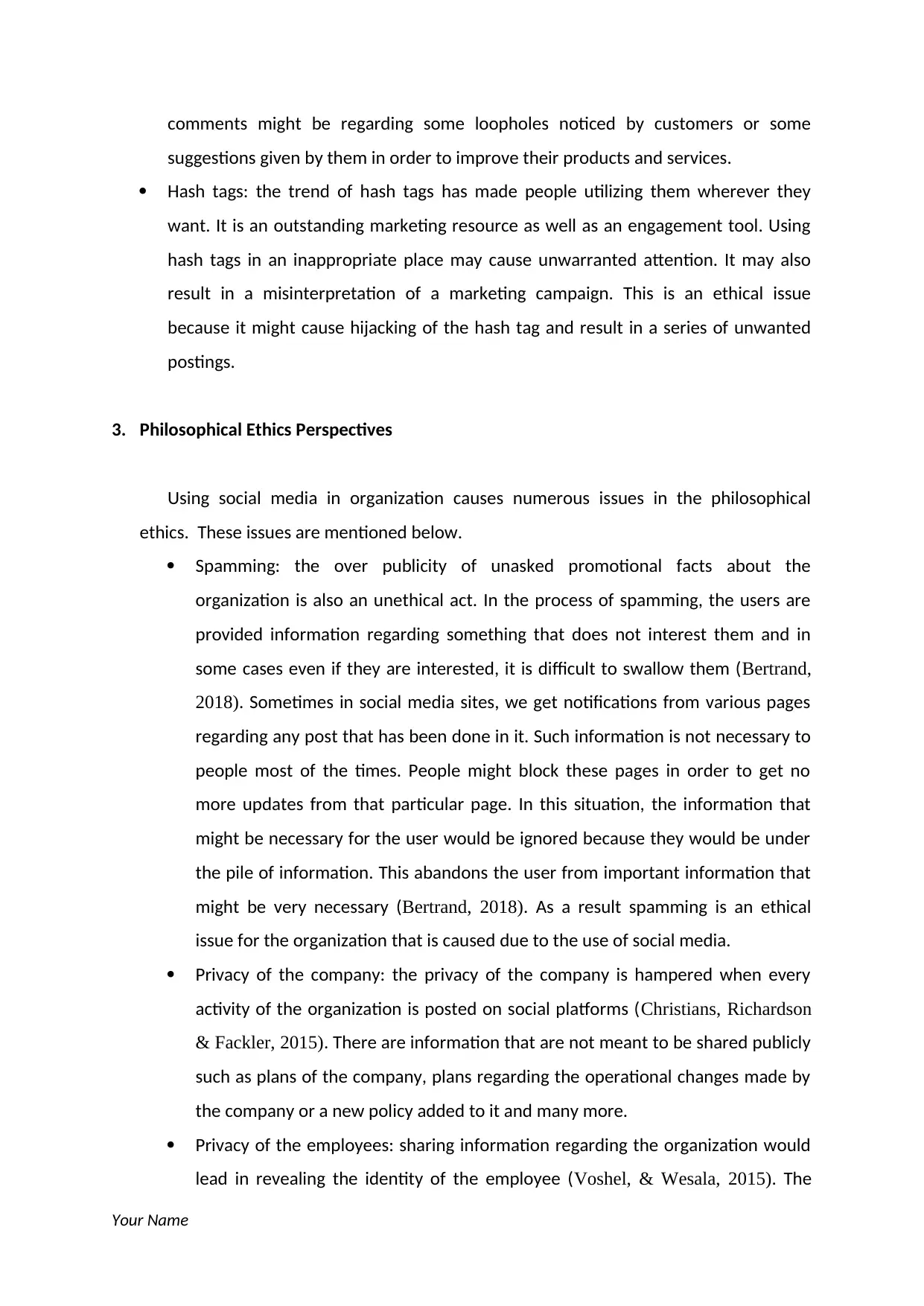
comments might be regarding some loopholes noticed by customers or some
suggestions given by them in order to improve their products and services.
Hash tags: the trend of hash tags has made people utilizing them wherever they
want. It is an outstanding marketing resource as well as an engagement tool. Using
hash tags in an inappropriate place may cause unwarranted attention. It may also
result in a misinterpretation of a marketing campaign. This is an ethical issue
because it might cause hijacking of the hash tag and result in a series of unwanted
postings.
3. Philosophical Ethics Perspectives
Using social media in organization causes numerous issues in the philosophical
ethics. These issues are mentioned below.
Spamming: the over publicity of unasked promotional facts about the
organization is also an unethical act. In the process of spamming, the users are
provided information regarding something that does not interest them and in
some cases even if they are interested, it is difficult to swallow them (Bertrand,
2018). Sometimes in social media sites, we get notifications from various pages
regarding any post that has been done in it. Such information is not necessary to
people most of the times. People might block these pages in order to get no
more updates from that particular page. In this situation, the information that
might be necessary for the user would be ignored because they would be under
the pile of information. This abandons the user from important information that
might be very necessary (Bertrand, 2018). As a result spamming is an ethical
issue for the organization that is caused due to the use of social media.
Privacy of the company: the privacy of the company is hampered when every
activity of the organization is posted on social platforms (Christians, Richardson
& Fackler, 2015). There are information that are not meant to be shared publicly
such as plans of the company, plans regarding the operational changes made by
the company or a new policy added to it and many more.
Privacy of the employees: sharing information regarding the organization would
lead in revealing the identity of the employee (Voshel, & Wesala, 2015). The
Your Name
suggestions given by them in order to improve their products and services.
Hash tags: the trend of hash tags has made people utilizing them wherever they
want. It is an outstanding marketing resource as well as an engagement tool. Using
hash tags in an inappropriate place may cause unwarranted attention. It may also
result in a misinterpretation of a marketing campaign. This is an ethical issue
because it might cause hijacking of the hash tag and result in a series of unwanted
postings.
3. Philosophical Ethics Perspectives
Using social media in organization causes numerous issues in the philosophical
ethics. These issues are mentioned below.
Spamming: the over publicity of unasked promotional facts about the
organization is also an unethical act. In the process of spamming, the users are
provided information regarding something that does not interest them and in
some cases even if they are interested, it is difficult to swallow them (Bertrand,
2018). Sometimes in social media sites, we get notifications from various pages
regarding any post that has been done in it. Such information is not necessary to
people most of the times. People might block these pages in order to get no
more updates from that particular page. In this situation, the information that
might be necessary for the user would be ignored because they would be under
the pile of information. This abandons the user from important information that
might be very necessary (Bertrand, 2018). As a result spamming is an ethical
issue for the organization that is caused due to the use of social media.
Privacy of the company: the privacy of the company is hampered when every
activity of the organization is posted on social platforms (Christians, Richardson
& Fackler, 2015). There are information that are not meant to be shared publicly
such as plans of the company, plans regarding the operational changes made by
the company or a new policy added to it and many more.
Privacy of the employees: sharing information regarding the organization would
lead in revealing the identity of the employee (Voshel, & Wesala, 2015). The
Your Name
Paraphrase This Document
Need a fresh take? Get an instant paraphrase of this document with our AI Paraphraser
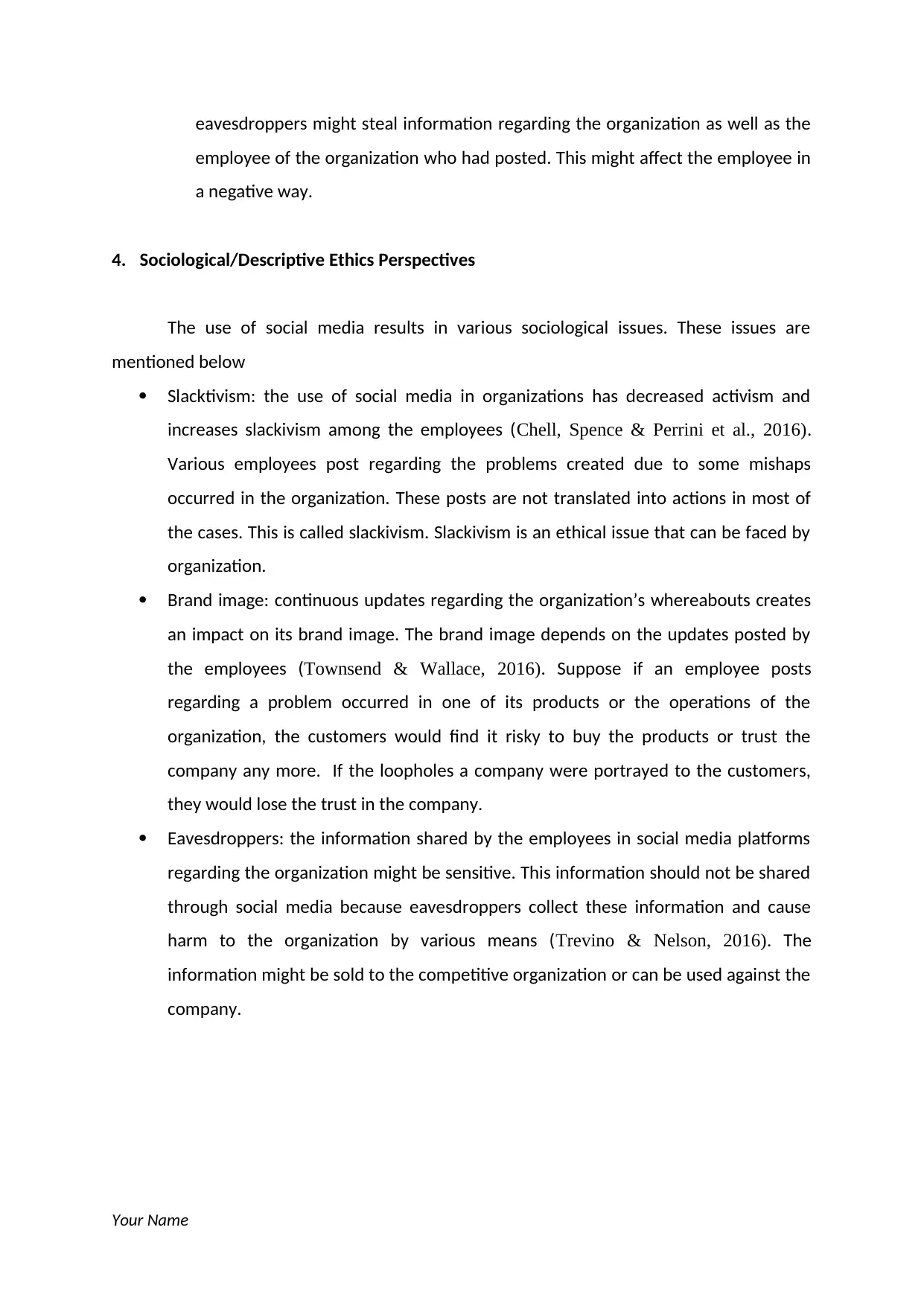
eavesdroppers might steal information regarding the organization as well as the
employee of the organization who had posted. This might affect the employee in
a negative way.
4. Sociological/Descriptive Ethics Perspectives
The use of social media results in various sociological issues. These issues are
mentioned below
Slacktivism: the use of social media in organizations has decreased activism and
increases slackivism among the employees (Chell, Spence & Perrini et al., 2016).
Various employees post regarding the problems created due to some mishaps
occurred in the organization. These posts are not translated into actions in most of
the cases. This is called slackivism. Slackivism is an ethical issue that can be faced by
organization.
Brand image: continuous updates regarding the organization’s whereabouts creates
an impact on its brand image. The brand image depends on the updates posted by
the employees (Townsend & Wallace, 2016). Suppose if an employee posts
regarding a problem occurred in one of its products or the operations of the
organization, the customers would find it risky to buy the products or trust the
company any more. If the loopholes a company were portrayed to the customers,
they would lose the trust in the company.
Eavesdroppers: the information shared by the employees in social media platforms
regarding the organization might be sensitive. This information should not be shared
through social media because eavesdroppers collect these information and cause
harm to the organization by various means (Trevino & Nelson, 2016). The
information might be sold to the competitive organization or can be used against the
company.
Your Name
employee of the organization who had posted. This might affect the employee in
a negative way.
4. Sociological/Descriptive Ethics Perspectives
The use of social media results in various sociological issues. These issues are
mentioned below
Slacktivism: the use of social media in organizations has decreased activism and
increases slackivism among the employees (Chell, Spence & Perrini et al., 2016).
Various employees post regarding the problems created due to some mishaps
occurred in the organization. These posts are not translated into actions in most of
the cases. This is called slackivism. Slackivism is an ethical issue that can be faced by
organization.
Brand image: continuous updates regarding the organization’s whereabouts creates
an impact on its brand image. The brand image depends on the updates posted by
the employees (Townsend & Wallace, 2016). Suppose if an employee posts
regarding a problem occurred in one of its products or the operations of the
organization, the customers would find it risky to buy the products or trust the
company any more. If the loopholes a company were portrayed to the customers,
they would lose the trust in the company.
Eavesdroppers: the information shared by the employees in social media platforms
regarding the organization might be sensitive. This information should not be shared
through social media because eavesdroppers collect these information and cause
harm to the organization by various means (Trevino & Nelson, 2016). The
information might be sold to the competitive organization or can be used against the
company.
Your Name
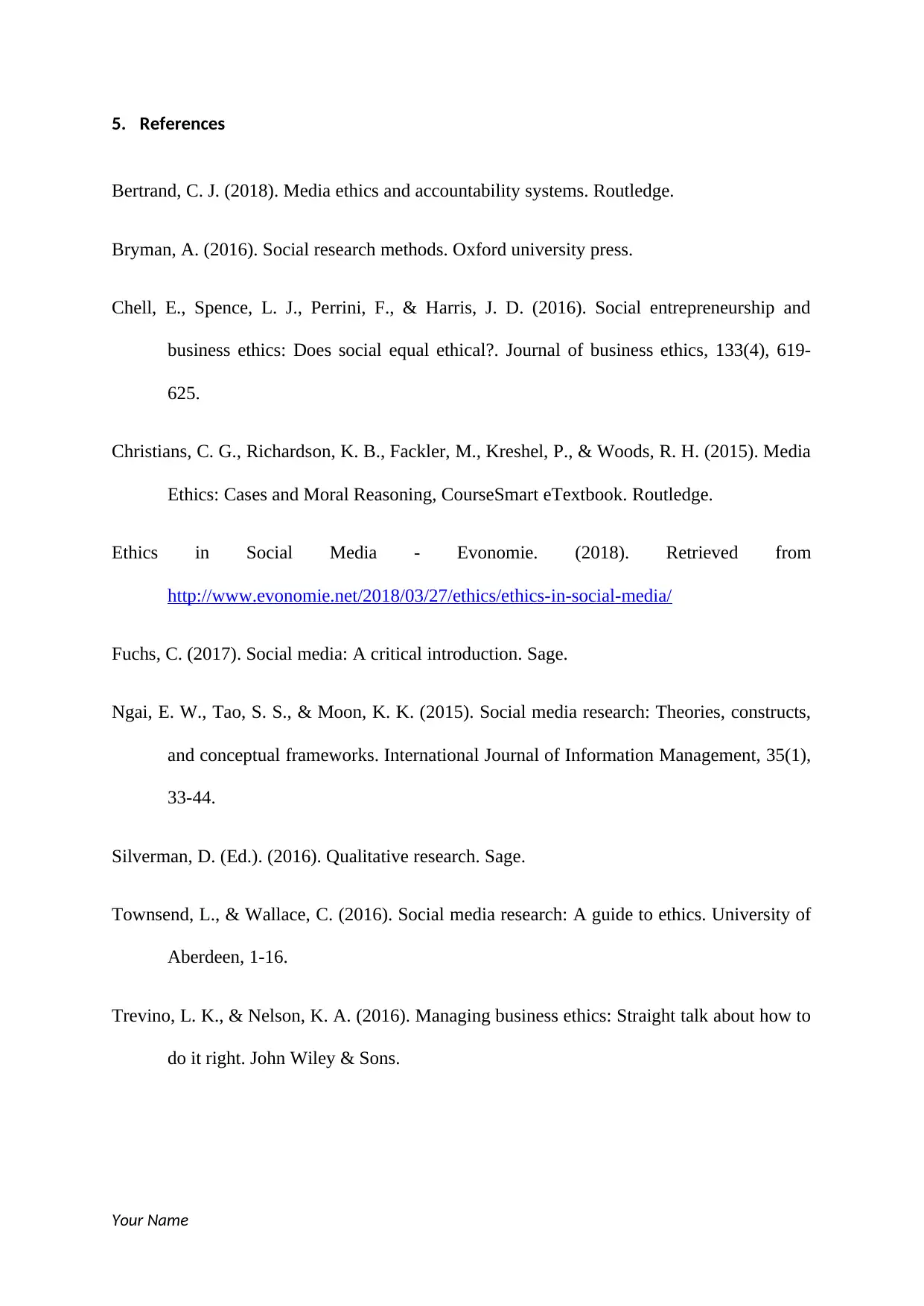
5. References
Bertrand, C. J. (2018). Media ethics and accountability systems. Routledge.
Bryman, A. (2016). Social research methods. Oxford university press.
Chell, E., Spence, L. J., Perrini, F., & Harris, J. D. (2016). Social entrepreneurship and
business ethics: Does social equal ethical?. Journal of business ethics, 133(4), 619-
625.
Christians, C. G., Richardson, K. B., Fackler, M., Kreshel, P., & Woods, R. H. (2015). Media
Ethics: Cases and Moral Reasoning, CourseSmart eTextbook. Routledge.
Ethics in Social Media - Evonomie. (2018). Retrieved from
http://www.evonomie.net/2018/03/27/ethics/ethics-in-social-media/
Fuchs, C. (2017). Social media: A critical introduction. Sage.
Ngai, E. W., Tao, S. S., & Moon, K. K. (2015). Social media research: Theories, constructs,
and conceptual frameworks. International Journal of Information Management, 35(1),
33-44.
Silverman, D. (Ed.). (2016). Qualitative research. Sage.
Townsend, L., & Wallace, C. (2016). Social media research: A guide to ethics. University of
Aberdeen, 1-16.
Trevino, L. K., & Nelson, K. A. (2016). Managing business ethics: Straight talk about how to
do it right. John Wiley & Sons.
Your Name
Bertrand, C. J. (2018). Media ethics and accountability systems. Routledge.
Bryman, A. (2016). Social research methods. Oxford university press.
Chell, E., Spence, L. J., Perrini, F., & Harris, J. D. (2016). Social entrepreneurship and
business ethics: Does social equal ethical?. Journal of business ethics, 133(4), 619-
625.
Christians, C. G., Richardson, K. B., Fackler, M., Kreshel, P., & Woods, R. H. (2015). Media
Ethics: Cases and Moral Reasoning, CourseSmart eTextbook. Routledge.
Ethics in Social Media - Evonomie. (2018). Retrieved from
http://www.evonomie.net/2018/03/27/ethics/ethics-in-social-media/
Fuchs, C. (2017). Social media: A critical introduction. Sage.
Ngai, E. W., Tao, S. S., & Moon, K. K. (2015). Social media research: Theories, constructs,
and conceptual frameworks. International Journal of Information Management, 35(1),
33-44.
Silverman, D. (Ed.). (2016). Qualitative research. Sage.
Townsend, L., & Wallace, C. (2016). Social media research: A guide to ethics. University of
Aberdeen, 1-16.
Trevino, L. K., & Nelson, K. A. (2016). Managing business ethics: Straight talk about how to
do it right. John Wiley & Sons.
Your Name
⊘ This is a preview!⊘
Do you want full access?
Subscribe today to unlock all pages.

Trusted by 1+ million students worldwide
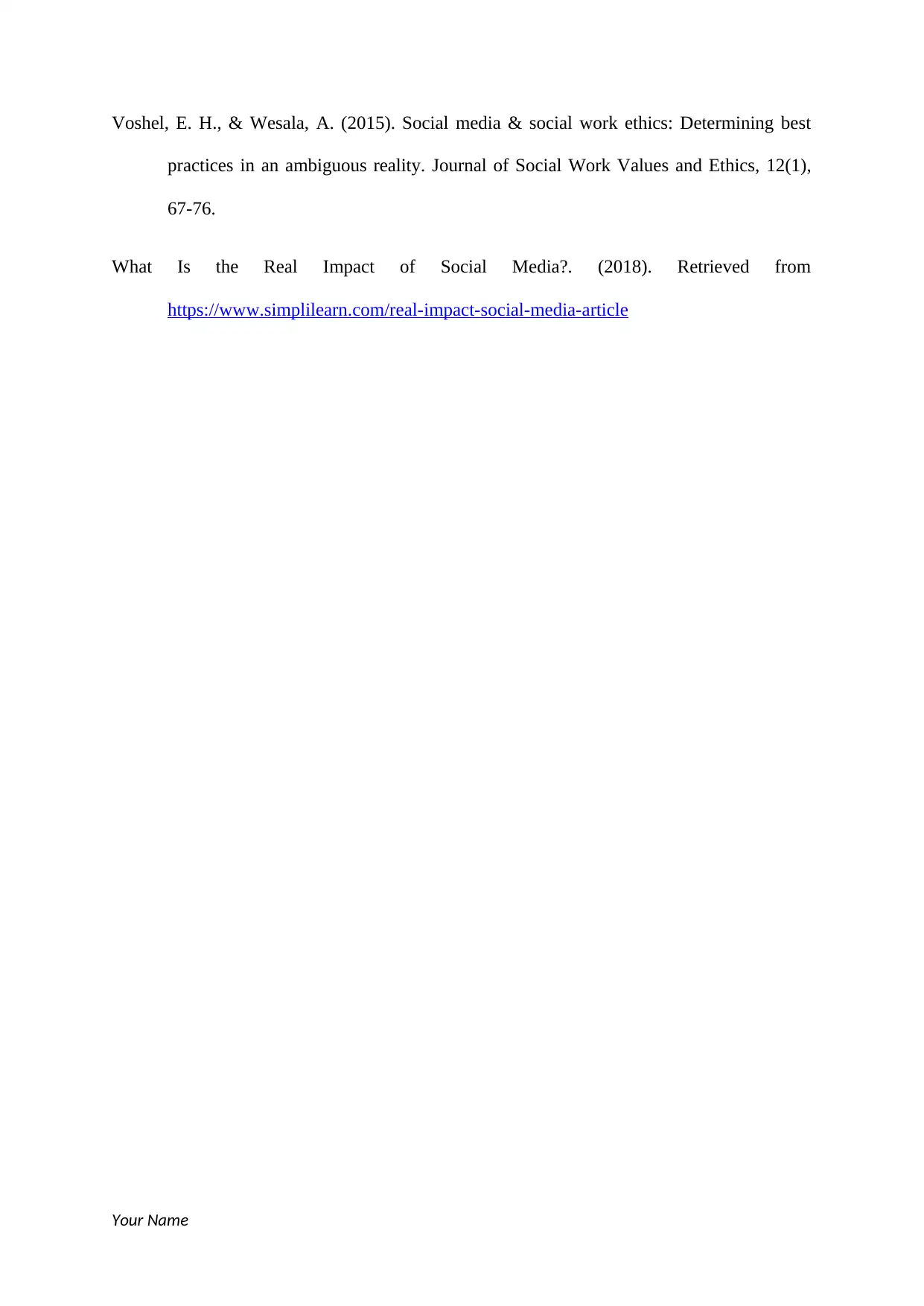
Voshel, E. H., & Wesala, A. (2015). Social media & social work ethics: Determining best
practices in an ambiguous reality. Journal of Social Work Values and Ethics, 12(1),
67-76.
What Is the Real Impact of Social Media?. (2018). Retrieved from
https://www.simplilearn.com/real-impact-social-media-article
Your Name
practices in an ambiguous reality. Journal of Social Work Values and Ethics, 12(1),
67-76.
What Is the Real Impact of Social Media?. (2018). Retrieved from
https://www.simplilearn.com/real-impact-social-media-article
Your Name
Paraphrase This Document
Need a fresh take? Get an instant paraphrase of this document with our AI Paraphraser
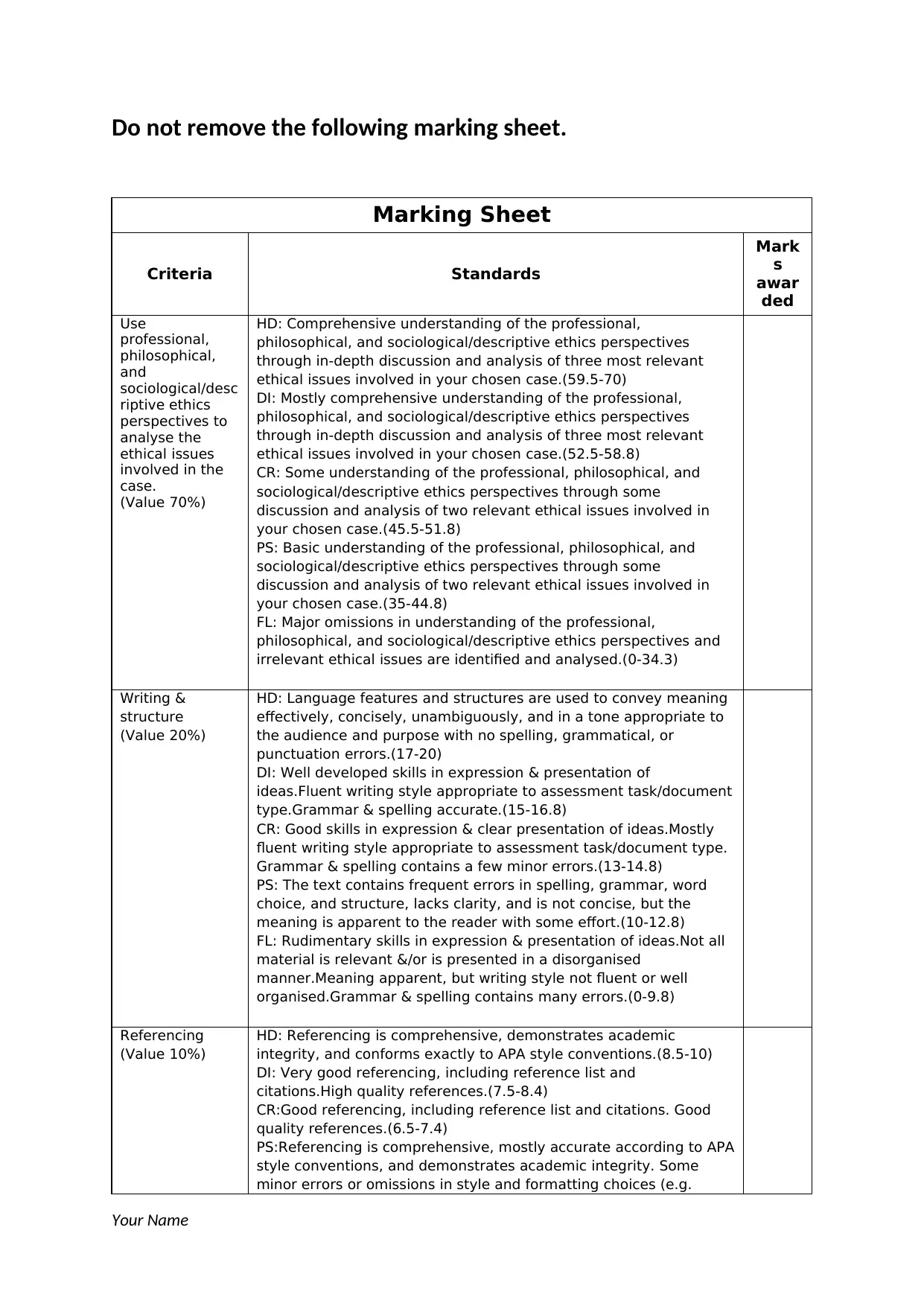
Do not remove the following marking sheet.
Marking Sheet
Criteria Standards
Mark
s
awar
ded
Use
professional,
philosophical,
and
sociological/desc
riptive ethics
perspectives to
analyse the
ethical issues
involved in the
case.
(Value 70%)
HD: Comprehensive understanding of the professional,
philosophical, and sociological/descriptive ethics perspectives
through in-depth discussion and analysis of three most relevant
ethical issues involved in your chosen case.(59.5-70)
DI: Mostly comprehensive understanding of the professional,
philosophical, and sociological/descriptive ethics perspectives
through in-depth discussion and analysis of three most relevant
ethical issues involved in your chosen case.(52.5-58.8)
CR: Some understanding of the professional, philosophical, and
sociological/descriptive ethics perspectives through some
discussion and analysis of two relevant ethical issues involved in
your chosen case.(45.5-51.8)
PS: Basic understanding of the professional, philosophical, and
sociological/descriptive ethics perspectives through some
discussion and analysis of two relevant ethical issues involved in
your chosen case.(35-44.8)
FL: Major omissions in understanding of the professional,
philosophical, and sociological/descriptive ethics perspectives and
irrelevant ethical issues are identified and analysed.(0-34.3)
Writing &
structure
(Value 20%)
HD: Language features and structures are used to convey meaning
effectively, concisely, unambiguously, and in a tone appropriate to
the audience and purpose with no spelling, grammatical, or
punctuation errors.(17-20)
DI: Well developed skills in expression & presentation of
ideas.Fluent writing style appropriate to assessment task/document
type.Grammar & spelling accurate.(15-16.8)
CR: Good skills in expression & clear presentation of ideas.Mostly
fluent writing style appropriate to assessment task/document type.
Grammar & spelling contains a few minor errors.(13-14.8)
PS: The text contains frequent errors in spelling, grammar, word
choice, and structure, lacks clarity, and is not concise, but the
meaning is apparent to the reader with some effort.(10-12.8)
FL: Rudimentary skills in expression & presentation of ideas.Not all
material is relevant &/or is presented in a disorganised
manner.Meaning apparent, but writing style not fluent or well
organised.Grammar & spelling contains many errors.(0-9.8)
Referencing
(Value 10%)
HD: Referencing is comprehensive, demonstrates academic
integrity, and conforms exactly to APA style conventions.(8.5-10)
DI: Very good referencing, including reference list and
citations.High quality references.(7.5-8.4)
CR:Good referencing, including reference list and citations. Good
quality references.(6.5-7.4)
PS:Referencing is comprehensive, mostly accurate according to APA
style conventions, and demonstrates academic integrity. Some
minor errors or omissions in style and formatting choices (e.g.
Your Name
Marking Sheet
Criteria Standards
Mark
s
awar
ded
Use
professional,
philosophical,
and
sociological/desc
riptive ethics
perspectives to
analyse the
ethical issues
involved in the
case.
(Value 70%)
HD: Comprehensive understanding of the professional,
philosophical, and sociological/descriptive ethics perspectives
through in-depth discussion and analysis of three most relevant
ethical issues involved in your chosen case.(59.5-70)
DI: Mostly comprehensive understanding of the professional,
philosophical, and sociological/descriptive ethics perspectives
through in-depth discussion and analysis of three most relevant
ethical issues involved in your chosen case.(52.5-58.8)
CR: Some understanding of the professional, philosophical, and
sociological/descriptive ethics perspectives through some
discussion and analysis of two relevant ethical issues involved in
your chosen case.(45.5-51.8)
PS: Basic understanding of the professional, philosophical, and
sociological/descriptive ethics perspectives through some
discussion and analysis of two relevant ethical issues involved in
your chosen case.(35-44.8)
FL: Major omissions in understanding of the professional,
philosophical, and sociological/descriptive ethics perspectives and
irrelevant ethical issues are identified and analysed.(0-34.3)
Writing &
structure
(Value 20%)
HD: Language features and structures are used to convey meaning
effectively, concisely, unambiguously, and in a tone appropriate to
the audience and purpose with no spelling, grammatical, or
punctuation errors.(17-20)
DI: Well developed skills in expression & presentation of
ideas.Fluent writing style appropriate to assessment task/document
type.Grammar & spelling accurate.(15-16.8)
CR: Good skills in expression & clear presentation of ideas.Mostly
fluent writing style appropriate to assessment task/document type.
Grammar & spelling contains a few minor errors.(13-14.8)
PS: The text contains frequent errors in spelling, grammar, word
choice, and structure, lacks clarity, and is not concise, but the
meaning is apparent to the reader with some effort.(10-12.8)
FL: Rudimentary skills in expression & presentation of ideas.Not all
material is relevant &/or is presented in a disorganised
manner.Meaning apparent, but writing style not fluent or well
organised.Grammar & spelling contains many errors.(0-9.8)
Referencing
(Value 10%)
HD: Referencing is comprehensive, demonstrates academic
integrity, and conforms exactly to APA style conventions.(8.5-10)
DI: Very good referencing, including reference list and
citations.High quality references.(7.5-8.4)
CR:Good referencing, including reference list and citations. Good
quality references.(6.5-7.4)
PS:Referencing is comprehensive, mostly accurate according to APA
style conventions, and demonstrates academic integrity. Some
minor errors or omissions in style and formatting choices (e.g.
Your Name
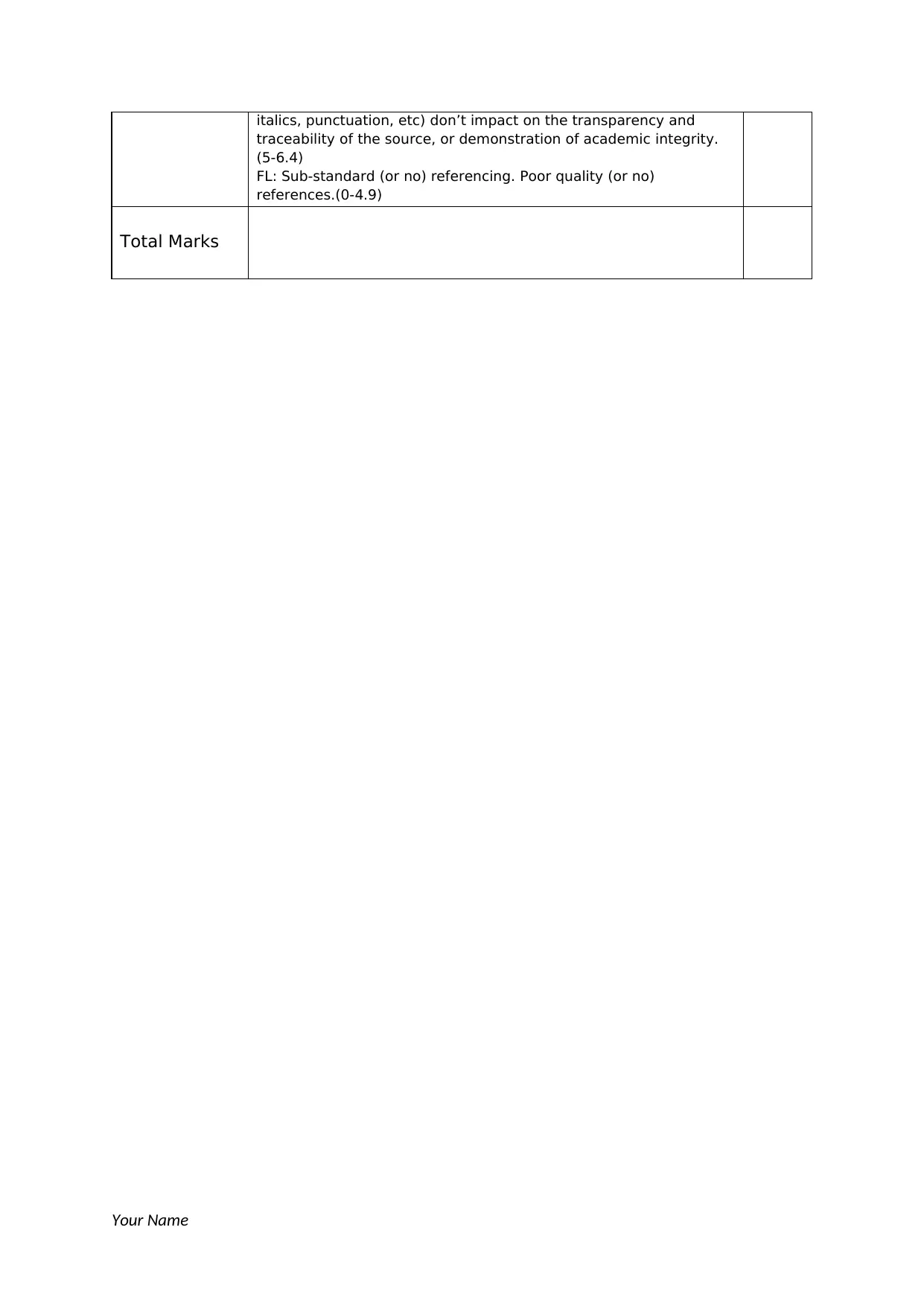
italics, punctuation, etc) don’t impact on the transparency and
traceability of the source, or demonstration of academic integrity.
(5-6.4)
FL: Sub-standard (or no) referencing. Poor quality (or no)
references.(0-4.9)
Total Marks
Your Name
traceability of the source, or demonstration of academic integrity.
(5-6.4)
FL: Sub-standard (or no) referencing. Poor quality (or no)
references.(0-4.9)
Total Marks
Your Name
⊘ This is a preview!⊘
Do you want full access?
Subscribe today to unlock all pages.

Trusted by 1+ million students worldwide
1 out of 9
Related Documents
Your All-in-One AI-Powered Toolkit for Academic Success.
+13062052269
info@desklib.com
Available 24*7 on WhatsApp / Email
![[object Object]](/_next/static/media/star-bottom.7253800d.svg)
Unlock your academic potential
Copyright © 2020–2025 A2Z Services. All Rights Reserved. Developed and managed by ZUCOL.



